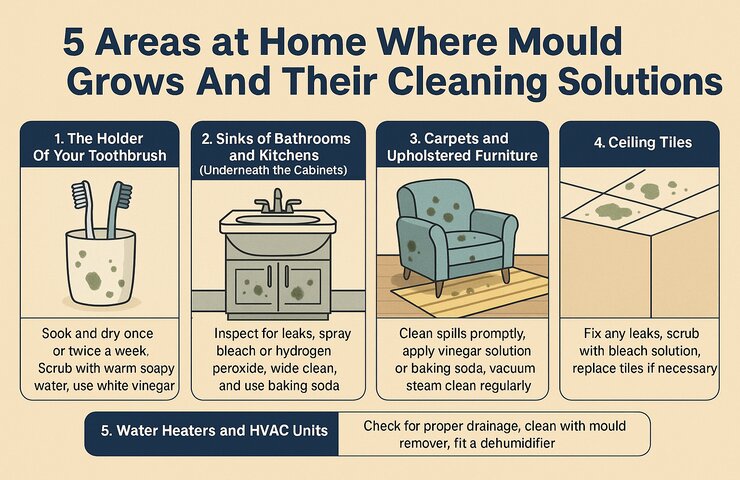Effective Cleaning Solutions for Common Mould-Prone Areas at Home
Cleaning a house of mould can be quite hard because it can grow almost anywhere. Moulds are organisms that are elongated and dark in colour, and they are often referred to as fungi. The accumulation of moisture and organic matter can kickstart mildew and mould growth. However, cleaning some of the specified key locations in a house that contain mould hot spots may be difficult, more so if you are cleaning out of a rented place. All places within the house need to be attended to, including those places that have remnants of mould and mildew that are hidden. Hiring professionals to do the end-of-lease cleaning on the Sunshine Coast is a good idea. They know how to get rid of mould and use effective, safe, eco-friendly cleaning solutions. This article will provide you with the steps on how to eliminate mould and mildew from your home. Below is the list of five household places where mould builds up and their cleaning hacks.
How To Clean Secret Mould Bases Within Your House
Mould can be elusive. It thrives best in places lacking light and moisture, and hence, an unwelcome stalker is prevalent in your home. People tend to remove the visible dirt and settle for that during their cleaning routine. However, mould spores that are lurking do not clear every window of opportunity provided to them, continue to develop in hidden spots and risk your well-being. To maintain the health standards of your home then you can hire end of lease cleaning Sunshine Coast. Here are areas that are zanily overlooked for cleaning, reasons as to why cleaning these areas can be helpful, and a list of tips to combat mould, cleaning, and prevention.
1. The Holder Of Your Toothbrush
At a glance, one would assume the holder of their toothbrush doesn’t hold any grudge against the hygiene nirvana. Unhygienic empires built, glass or ceramic moulds, which aren’t renewable, make matters so much worse. These utopias are poorly cleaned, meaning that every single piece of dental equipment fulfils its purpose. Water drowns toothbrushes, mouthwash, which have overflowed their galleys of containment and slip freely. Shoes go into dip jars like mints and flooded, like badly maintained gardens, begin to drown sinks and so on. The toilet’s great reset that emptiness toilet paper, reminiscing fully remembers in its puffy self. Without daily divine choirs, sans heavenly graces, give birth to nourish infections. And mould thrives.
Instructions for Cleaning Considerations:
To address this particular problem, soak and dry your toothbrush holder once or twice a week. Scrub the bottom with warm water and soap to get rid of any residue and remove any mould. If stubborn mildew stains exist, white vinegar or a disinfecting cleaner will do well to get rid of any lingering germs. After the clean, make sure it is dried completely before placing the toothbrushes back. If possible, use an open-air toothbrush holder which allows for increased airflow to help reduce moisture build-up.
2. Sinks of Bathrooms and Kitchens (Underneath the Cabinets)
The area under your bathroom sink and kitchen sink cabinets are a breeding ground for mould due to lack of light and dampness. If you add leaking pipes or taps, this hidden area transforms into a mould spore ever-growing environment. This space is normally ignored during cleaning, but if you tend to do a deep cleaning before moving out of a rental unit, this is important to check.
How to Clean:
Start cleaning by removing the contents of the cabinet and looking for signs of leakage on the plumbing. Repair any underlying problems if moisture or water damage is present. Besides, when cleaning the interior of the cupboard with either bleach or a hydrogen peroxide solution, spray it on the affected area and allow it to be absorbed for 15 to 20 minutes to disinfect the mould. Take away using a microfiber cloth. To keep mould away, place some baking soda or silica gel inside the cupboard. If there is profound mould growth, consider using professional end-of-lease cleaning services in the Sunshine Coast, which will meticulously remove mould using industrial equipment and eco friendly products.
3. Carpets and Upholstered Furniture
You might not expect this, but furniture such as carpets, rugs, and upholstered items that get little to no cleaning done to them are primary culprits for mould growth. These soft surfaces are ideal for mould because they capture dust, dirt, pet fur, dead skin, and even moisture. Stains from coffee, juice, or wine further exacerbate the problem if not taken care of immediately.
Cleaning Directions:
Carpets and other such furnishings can develop mould if any spills happen, so it’s best to clean them immediately. Moulds can be eliminated by either soaking a cloth in a warm water and vinegar solution, or sprinkling some baking soda on the area that is damp. After some hours, the baking soda can be vacuumed away. Regular dusting and vacuuming also help keep the furnishings clean. Steam cleaning upholstery and area rugs every couple of months is suggested. To keep mould from forming, ensure that your home is adequately ventilated, as it lowers the humidity. In instances of heavy mould damage deep within carpets or fabrics, you just might need a professional cleaner.
4. Ceiling Tiles
The ceiling tiles are sadly another item cropped off the list for maintenance because their days usually go unnoticed. If there is some ductwork or piping above your ceiling, then these tiles become a big sponge for moisture. Mould can grow with warmth, moisture, and dust. Most often, stains or discolouration become a clue that something is growing right underneath the ceiling.
How to Clean:
Check for leaks from the roof, pipes, or HVAC system first. Ongoing moisture should be repaired before cleaning. After that, scrub the affected ceiling tiles with a bleach-based cleaning solution. Either a sponge or a spray bottle can be used to apply the solution, which must then be wiped clean after 10–15 minutes. If mould has deeply infiltrated the tiles or insulation, deterioration may be the best approach. Conducting frequent inspections of the ceiling’s perimeter, especially the basement and attic, makes it easier to prevent bigger problems later on.
5. Water Heaters and HVAC Units
Internal drains are normally installed in water heaters, boilers, and HVAC systems to carry away excess moisture. However, over a duration of time, those drains begin clogging or rusting, leading to the accumulation of water and forming mould on the base of walls and adjacent walls or walls dispersing mould spores into the air.
How to Clean:
You should be checking the water heater and HVAC system for proper drainage every month. If any rust, corrosion, or mould is present, rectify that straight away. Use a cloth with a mould removal solution or a bleaching agent and wipe the region. For disinfection, let the solution stay for a couple of minutes, then scrub and rinse thoroughly. Fit a dehumidifier to keep the area dry, particularly in closet-style utility rooms. A professional should be consulted for deep cleaning and maintenance of the appliances.
Conclusion
Treat all nasty surfaces with mould the moment they come into sight. Remember to inspect not only the common areas, but also the rental units, and try to maintain the premise and properly ventilated. If they require cleaning, expert help is needed for bond clean Brisbane. Their intervention restores the property to its original glory, undoing any pre-lord inspection damage.



